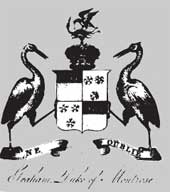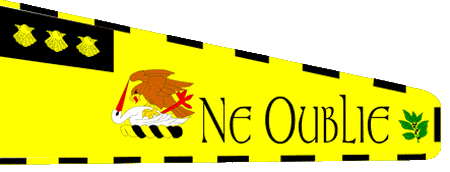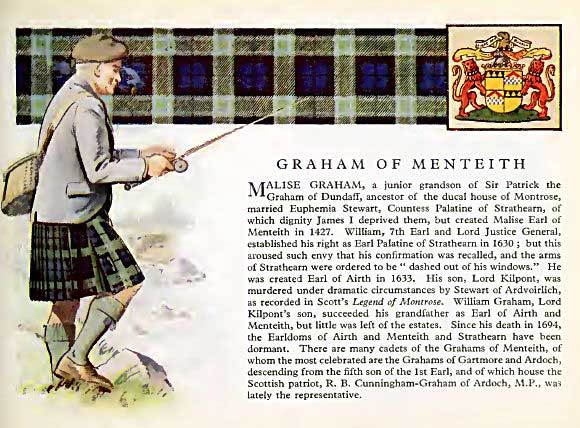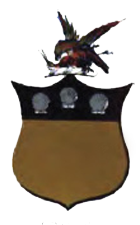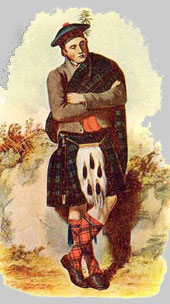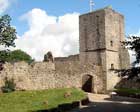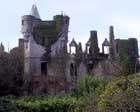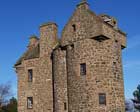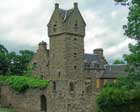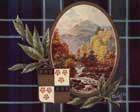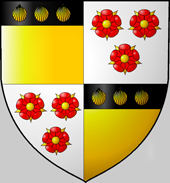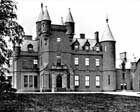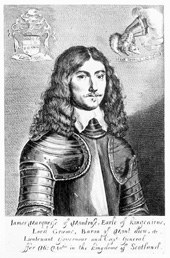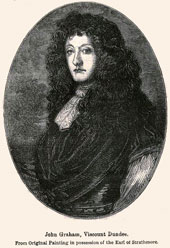- Clan Name: Graham - Graeme, Grahame.
- Clan Motto: Ne Oublie - Never Forget
- Clan Chief: James Graham 8th Duke of Montrose
- Clan Seats: Buchanan Castle by Drymen, Stirlingshire.
- Clan Lands: .
- Clan Tartan :
- Clan links : Clan Graham Society
- Clan links :
- Clan links :
Clan History
The first documented Graham seems to be a William de Graham who received lands at Abercorn and Dalkeith from King David 1st in 1127. He must have been a respected gentleman as in the next year his signature is given as witness to the charter founding the Abbey at Holyrood.
His elder son Peter, started the Grahams of Dalkeith and Eskdale branch of the family
and his younger son Alan, founded the Grahams of Montrose line.
In the 13th century the clan chief, Sir David de Graham, married the Earl of Strathearn's daughter receiving the lands in Kincardine ( Strathearn ) as a dowry. He started in motion the building of a castle there and Kincardine Castle, albeit a newer version, still stands today.
Sir John Graham of Dunduff fought alongside William Wallace and fell at the Battle of Falkirk in 1298. His son David stepped into the Chieftainship and fought under Robert the Bruce receiving a knighthood as reward.
Sir David's great-grandson, Sir William Graham of Kincardine, married Mary Stewart daughter of King Robert 2nd, who ruled between 1371-1390.
Land and power just kept coming, in 1451 the Grahams acquired the lands of Old Montrose in Angus and in 1451 Patrick Graham of Kincardine was promoted to Lord Graham.
His grandson the 3rd Lord fought with Great Valour at the Battle of Sauchieburn in 1488 and in 1504 was made Earl of Montrose. He fell at the Battle of Flodden in 1513.
James Graham the 5th Earl and 1st Marquis of Montrose, was without doubt one of the highest achievers in the Graham history he was educated at St Andrews university and completed his education in France and Italy returning to Scotland in 1637.
It didn't take long until he got involved in religious disputes in the Aberdeen area especially with the Gordons at that time.
In the English civil war he sided with the Covenanter's and as the war developed he became disillusioned with their cause and switched allegiances to the Royalists.
He led the royalist forces to great victories among them the Battle of Inverlochy in 1645, where despite being heavily outnumbered his army disposed of over 1200 Campbells who with the Duke of Argyll were the power house of the Scottish Covenanter forces at that time. He moved on to plunder Dundee and win battles at Auldearn, Alford and Kilsyth. The English had to withdraw covenanter forces from conflict in England to help in the fight against Montrose who by this time more or less had control of Scotland.
This was all to the benefit of King Charles 1st, who unfortunately had suffered a crushing defeat at the Battle of Nasenby on 14th June. Montrose had to take his army south to help and this was to prove very unpopular with his army who were mainly highlanders and were not so keen on traveling so far to "help the English", the numbers started to reduce the further south they marched. In August 1645 Montrose moved into the lowlands and the next month got caught by General David Leslie with a large Covenanter force at Philiphaugh. Montrose's highlanders had already gone and he was left with only a small group of followers who were massacred. Montrose escaped and for the next year tried to raise another army but when King Charles surrendered to the covenanters he asked Montrose to cease fighting for the cause. Montrose left for Norway.
In 1649 Charles 1st was executed and Charles 2nd * offered Montrose the post of Captain-General of Scotland. When, in 1650 under orders of his King, (who had been covertly making power trading deals with the covenanters in England) he was betrayed and captured. He was taken to Edinburgh and already under the death sentence for his campaign of 1644-5, Montrose was hanged at the Mercat Cross on 21 May 1650 and his head was fixed on a spike at the Tolbooth, his legs and arms were fixed to the gates of Stirling, Perth, Glasgow and Aberdeen.
After the Restoration ( of the Royal family ), Montrose's embalmed heart and bones were buried at the High Kirk of St Giles in Edinburgh in May of 1661. There was a large procession with fourteen noblemen bearing the coffin.
Montrose's son James was confirmed as the bearer of the re-instated Montrose titles.
In the time of his son, James the 2nd Marquess of Montrose, the Kincardine Castle was attacked and destroyed by an army of Campbells.
In 1682, the 3rd Marquess acquired land at Loch Lomond that had been in possession of the Buchanan chiefs.
The other hero would have to be Bonnie Dundee. He was born 2 years before his fellow clansman Montrose was hung drawn and quartered. John Graham of Claverhouse, 1st Viscount Dundee, graduated from St Andrews university in 1661.
At the age of 24 he started learning the art of warfare while serving in Sir William Lockart's Scots Regiment, helping Lious the 14th in France. He returned to Scotland 4 years later older and wiser.
In 1678 he was tasked by King Charles 2nd to stamp out religious rebellion and anti-Royalist objectors in the Scottish borders. enforcing law as the King saw it,
He fought hard against the covenanters and earned the nickname of "bluidy Clavers" for the zealous way he meted out punishment. He met the King in 1680 and so impressed him with his aptitude that within six years he rose to the rank of major-general and Provost of Dundee. In two years he was created Viscount Dundee by King James 7th.
In 1689 Scotland decided to follow England in declaring James as abdicated, when he fled abroad this opened the door to William and Mary of Orange who were jointly awarded the crown.
Dundee, out of loyalty to King James, raised an army mainly of highlanders with a view to restoring the Stuart line to the throne. On the 27th July 1689 this Jacobite army met the Williamite army at the Battle of Killiecrankie. Dundee with 2400 men against General Hugh Mackay with 3500 lowlanders.The Jacobites won the day, inflicting large losses on the opposing side. Tragically during a cavalry charge a musket ball deflected up through the breast-plate and Dundee was mortally wounded.
Even with the victory, such was the charisma of Dundee, that when he died so did the cause. They did carry on for a bit but most had lost their commitment. The Battle of the Boyne in the following year finally ended James's ambition's though not the Stuart's claim, although this was 57 years before Culloden it was the only Jacobite venture of the clan they remained neutral during the others.
The Bonnets o' Bonnie Dundee
Tae the lairds i' convention t'was Claverhouse spoke
E'er the Kings crown go down, there'll be crowns to be broke;
Then let each cavalier who loves honour and me
Come follow the bonnets o' bonnie Dundee.
Chorus:
Come fill up my cup, come fill up my can,
Saddle my horses and call out my men.
And it's Ho! for the west port and let us gae free,
And we'll follow the bonnets o' bonnie Dundee!
Dundee he is mounted, he rides doon the street,
The bells they ring backwards, the drums they are beat,
But the Provost, douce man, says; Just e'en let him be
For the toon is well rid of that de'il o' Dundee.
There are hills beyond Pentland and lands beyond Forth,
Be there lairds i' the south, there are chiefs i' the north!
There are brave Duniewassals, three thousand times three
Will cry "Hoy!" for the bonnets o' bonnie Dundee.
Then awa' tae the hills, tae the lea, tae the rocks
E'er I own a usurper, I'll couch wi' the fox!
Then tremble, false whigs, in the midst o' your glee
Ye hae no seen the last o' my bonnets and me.
*
In 1707 James Graham, 4th Marquess, was created the 1st Duke of Montrose
by Queen Anne.
Clan Castles
Mugdock Castle is located 12 miles north of Glasgow. It was the seat of the chiefs of the Clan Graham Dukes of Montrose from 1372 until 1700.
In 1641 the castle was partly destroyed on orders from Parliament, but James Graham lived there until 1644. After the execution of James ( Montrose ) in 1650, the lands were forfeited to the Marquis of Argyll, Archibald Campbell. In 1655 Mugdock was returned back to the Grahams but the castle was in an uninhabitable condition. The Grahams spent two years trying to restore it to it's former glory but it never quite became what it used to be.
In 1682 the Grahams bought Buchanan Old House near Drymen together with other surrounding lands from the Buchanan Clan. This was to be developed into a more comfortable dwelling where one can entertain and more suitable as the home of a Marquis. In 1852 while the family were in London for christmas the house burned to the ground. Today there remains only three walls to show where it once stood.
Buchanan Castle is really a large gothic baronial mansion built to replace the old house in 1854. An impressive structure it was to be the new clan seat and a fitting place for the
Dukes of Montrose. It stayed in Graham hands, although latterly was leased out, it was sold in 1925. Today the castle still stands but is in a very poor condition.
Kincardine Castle is located 1 mile South of Auchterarder, it is really a large castellated mansion house than a castle and was built during the 19th century. The original castle is a ruin slightly farther up the glen. It was initially built by Sir David de Graham in the 13th century. James Graham, 1st Marquis of Montrose, lead the Covenanting Forces in the 1640s, and, after his defeat his lands were forfeited, Kincardine was burned and demolished by the Earl of Argyll in 1646. In 1660 a lot of the stones were used to build the local church in Auchterarder, the old church tower still remains and has a plaque stating such.
Claypotts Castle is located in Dundee on the east coast. It was built in 1569 and bought by the Sir William Graham of Ballunie in 1601. It became the property of Bonnie Dundee and after his death at Killiekrankie in 1689 became the property of the crown. It was given to the Douglas's in 1694. The castle is a good and characteristic example of it's period with an oblong central structure built on four floors and two towers built on diagonal corners. The rooms in the round towers are square internally and corbelled out to be square on the outside at the top.
Dalkeith Castle located just to the south of Edinburgh was first built in 1140. When John Graham of Dalkeith died in 1341 he had no heirs. The castle and lands passed to his sister Marjory who was married to Sir William Douglas of Lothian. The castle was to remain in Douglas hands until sold to the Buccleuch family three hundred years later.
Mains Castle was built by Sir David Graham in 1562, it is located in Fintry, Dundee and was the seat of the Grahams of Fintry until around 1856 when it was sold.
Inchtalla Castle or Talla Castle is located on an island in the Lake of Mentieth
( Scotland's only lake ). It was the seat of the Grahams, Earls of Menteith, built in the 17th century and now a ruin.
Kilbryde Castle is about 3 miles north of Dunblane on the bank of the Ardoch burn. It was built by Sir John Graham in 1460 and stayed in the Clan under the Earls of Menteith banner for nearly two hundred years. In 1669 it was sold to Sir Colin Campbell and is still in Campbell hands today.
James, the 8th Duke of Montrose lives on the ancestral estates, at Auchmar near Loch Lomond.
* An odd period when Charles 2nd was accepted as the new King of Scotland, which was still a separate Kingdom, while England was still under the rule of Cromwell and it took another 9 years until Cromwell died and England accepted him as their ruler.
